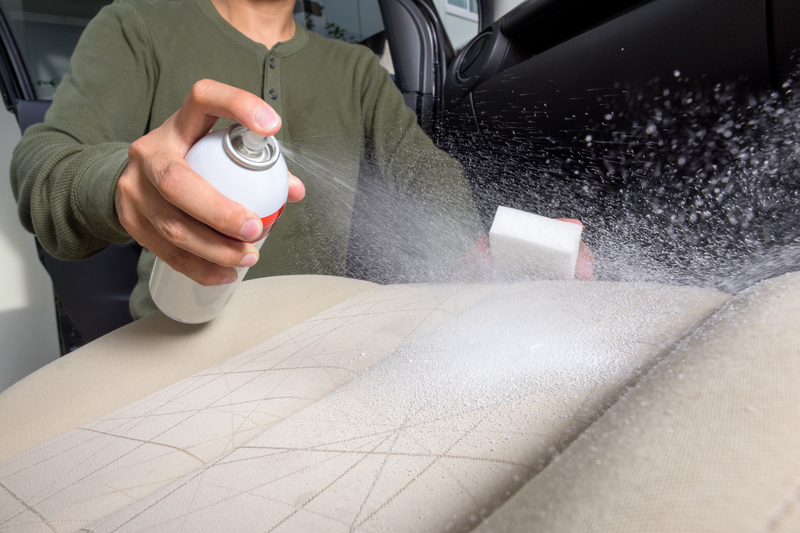Graceful Guardians: Master the Method to Wash Velvet Curtains Safely
Posted on 07/06/2025
Graceful Guardians: Master the Method to Wash Velvet Curtains Safely
Velvet curtains add a touch of elegance, luxury, and sophistication to any living space. These stunning, graceful guardians of your privacy not only keep out excessive light but also elevate the decor of a room. Because of their regal appearance, velvet drapes are a homeowner's favorite. However, their beauty comes with a unique challenge: How do you wash velvet curtains safely without damaging their plush texture or vivid color?
If you've ever hesitated before tackling velvet curtain cleaning, you are not alone. Many fear harming the delicate pile or warping the fabric. Fortunately, by learning the correct methods and practicing gentle care, you can keep your velvet drapes looking as stunning as the day you hung them. This comprehensive guide will walk you through everything you need to know to safely clean, maintain, and prolong the life of your luxurious velvet curtains.

Why Proper Care Matters for Velvet Curtains
Velvet, known for its deep pile and sumptuous texture, is a fabric that demands respect. Its unique weave, composed of either natural fibers like silk and cotton or synthetics like polyester, makes it susceptible to crushing, fading, and watermarks when mishandled. Proper velvet curtain cleaning not only preserves the lush pile but also protects the investment you have made in your home's ambiance.
- Maintain their rich color: Incorrect washing can lead to color bleeding or fading.
- Protect the fabric structure: Improper washing or drying can crush the plush pile.
- Extend curtain lifespan: Routine gentle care helps your curtains last for years.
Understanding Velvet Types: What Are Your Curtains Made Of?
Before you even think about washing your velvet drapes, it's crucial to identify the type of velvet you're working with. Not all velvet is created equal, and your cleaning approach will vary depending on the material. Here are the most common types:
- Cotton Velvet: Lush and absorbent, often used for premium curtains. Can shrink if washed improperly; dry cleaning usually recommended.
- Synthetic Velvet (Polyester, Rayon): More affordable, with better durability. Some are washable, but always check care labels.
- Silk Velvet: The most delicate and luxurious. Never machine washable; strictly dry clean only.
- Crushed or Embossed Velvet: Characterized by its unique texture which can flatten if exposed to water or excessive heat.
Tip: Always check for a care label before cleaning. If the label says "Dry Clean Only", don't risk at-home washing. When in doubt, consult a professional.
Preparation Before Washing Velvet Curtains
Proper preparation can make a huge difference in the outcome and longevity of your velvet drapes. Follow these essential steps before you start any cleaning process:
1. Vacuum to Remove Loose Dust and Dirt
Use a handheld vacuum with a soft brush attachment. Gently run it over the curtain's surface to lift any dust, dirt, or pet hair. Regular vacuuming prevents grime from embedding deeper into the fibers, which can make deep cleaning easier and safer.
2. Conduct a Spot Test
Mix a mild detergent with water and dab a tiny hidden section of the curtain. After waiting a few minutes, check for any color bleeding, texture changes, or watermarks. If no problems occur, proceed with your chosen cleaning method.
3. Read the Manufacturer's Instructions
Always follow the manufacturer's care instructions provided on the label. If instructions prescribe dry cleaning only, do not attempt to wash the velvet curtains at home.
How to Wash Velvet Curtains Safely: Step-By-Step Instructions
The method you use to clean velvet curtains will depend on the type of velvet, the amount of dirt, and the label instructions. We'll cover three reliable methods:
- Spot-cleaning velvet curtains
- Hand-washing velvet curtains
- Dry-cleaning or professional cleaning
Spot-Cleaning Velvet Curtains
For small stains or localized dirt, spot-cleaning is the safest way to care for your luxury velvet drapes at home.
- Blot the spill: Immediately blot with a clean, dry microfiber cloth. Never rub; rubbing can push the stain into the pile.
- Apply a mild solution: Mix a small amount of gentle detergent with cold water. Dampen a clean sponge or white cloth (not soaked) and gently dab the affected area.
- Blot excess moisture: Use another dry cloth to blot, absorbing as much liquid as possible.
- Dry naturally: Allow to air dry, keep away from direct sunlight or heat sources that could damage the fabric.
Note: For tough stains or oil-based spills, consult a professional cleaner specializing in velvet textiles.
Hand-Washing Velvet Curtains
Only attempt hand-washing if your curtains are labeled "washable." This method is best for synthetic velvet curtains.
- Fill a tub or basin with cold water: Hot water may cause shrinkage or pile damage.
- Add a delicate fabric detergent: Use a mild, non-alkaline detergent, avoiding bleach or harsh chemicals.
- Submerge gently: Swirl the curtains carefully. Do not twist or wring; instead, gently squeeze the fabric.
- Rinse with cold water: Ensure all soap is removed and water runs clear.
- Lay flat and press water out: Place the curtain between two dry towels and gently press. Don't wring or squeeze tightly, as this can distort the pile.
- Hang to air dry: Use a sturdy, padded hanger or a flat drying surface away from direct sunlight. Never tumble dry velvet curtains!
Machine Washing Velvet Curtains (With Caution!)
- Only machine wash if label clearly states it's safe.
- Use a gentle or delicate cycle with cold water.
- Place curtains in a large mesh laundry bag for extra protection.
- Use minimal mild detergent and skip fabric softener.
- Remove promptly, reshape, and air dry flat or hang carefully.
Warning: Never wash silk or cotton velvet curtains in a washing machine, as the agitation and water can permanently crush or ruin the pile.
Dry-Cleaning or Professional Cleaning
When in doubt, or when dealing with expensive natural velvet, always opt for professional cleaning.
- Professional dry cleaners use specialized solvents and machines safe for delicate velvets.
- This method protects texture and color and is recommended for silk velvet or antique drapes.
Drying and Finishing Velvet Drapes
Once cleaned, proper drying and finishing techniques are crucial to preserve the plush beauty of your velvet curtain panels.
How to Dry Velvet Curtains
- Never wring or twist: This distorts the fibers. Instead, gently press between towels.
- Lay flat or hang carefully: Air dry in a cool, dry, shaded space. Keep away from direct sun or heat.
- Let gravity help: Hanging helps prevent creasing and restores the natural drape.
Removing Wrinkles and Restoring Velvet's Pile
- Use a handheld steamer: Hold it a few inches away and gently steam down the length of the curtain, taking care not to soak the fabric. This relaxes creases and perks up the pile.
- Soft-bristle brush: Once dry, use a special velvet brush or soft clothes brush to gently fluff up the nap in the direction of the pile.
- Avoid irons: Never iron directly. If absolutely necessary, use the lowest setting with a pressing cloth between the iron and fabric, and only iron the lining (not the velvet itself).
Maintaining Velvet Curtains Between Washes
Regular maintenance is key to minimizing the need for deep cleaning. Try these tips to keep your luxurious velvet drapes looking their best between washes:
- Vacuum weekly with a soft attachment.
- Shake out gently to remove surface dust or pet hair.
- Spot-clean as soon as you notice a spill.
- Use curtain tiebacks to minimize friction and crushing of the pile against walls or windows.
- Rotate or reposition curtains every few months if possible to avoid uneven fading.
Frequently Asked Questions about Washing Velvet Curtains
Can you machine wash velvet curtains?
Only certain synthetic velvets with "machine washable" labels are safe for machine washing. Always use cold water and a delicate cycle, and avoid machine washing natural, cotton, or silk velvet curtains to prevent damage.
How often should you clean velvet drapes?
For most homes, thorough cleaning is needed every 6-12 months. Spot-clean or vacuum more frequently in high-traffic areas or in homes with pets and children.
What's the best way to remove wrinkles from velvet curtains?
A handheld steamer is best for releasing wrinkles and refreshing the pile. Avoid direct ironing to prevent pile damage.
Are all velvet curtains "dry clean only"?
No. Check the label: Some modern synthetic velvets are designed for hand-washing or machine washing, while natural velvets (cotton, silk) are almost always "dry clean only."
Can you iron velvet drapes?
Direct ironing is not recommended. If you must, use a pressing cloth and iron only the lining on the lowest heat setting.
Expert Tips for Stunning Velvet Curtain Results
- Test before you clean--always.
- Wash infrequently: The less you clean, the better for the pile.
- Avoid harsh chemicals: Stick to gentle detergents designed for delicates.
- Restore pile with steaming rather than brushing vigorously.
- Consult with professional cleaners, especially for antique or valuable velvet drapes.

When Is It Time to Replace Your Velvet Curtains?
Even with flawless care, velvet curtain panels may eventually show signs of wear and age. Indicators for replacement include:
- Tears, thinning, or excessive crushing of the pile that cannot be restored.
- Persistent odor, even after professional cleaning.
- Severe discoloration or fading that compromises the look of your decor.
In Conclusion: Honor Your Graceful Guardians
Velvet curtains are the graceful guardians of style and comfort in your living space. By mastering the correct cleaning techniques, understanding your curtain's unique fiber type, and practicing gentle but regular maintenance, you can ensure your plush velvet drapes remain stunning for years. When in doubt, professional cleaning always keeps your investment safe. Respect their luxury, and these elegant window treatments will continue to cast a warm, inviting glow.
Ready to let your velvet curtains shine again? Follow these washing and care tips to make your divine drapes the pride of your home, season after season!




